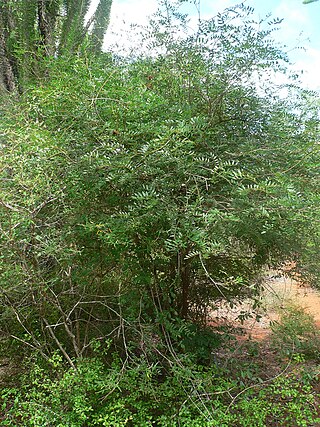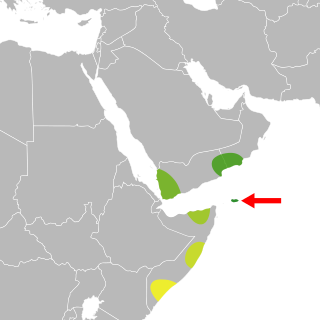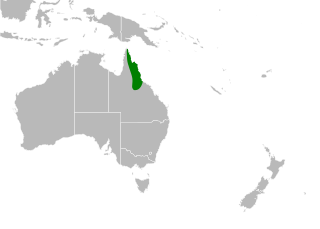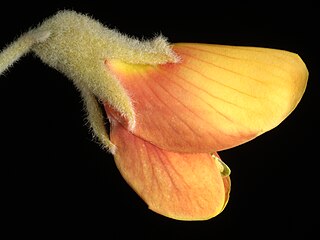
The Fabaceae or Leguminosae, commonly known as the legume, pea, or bean family, are a large and agriculturally important family of flowering plants. It includes trees, shrubs, and perennial or annual herbaceous plants, which are easily recognized by their fruit (legume) and their compound, stipulate leaves. The family is widely distributed, and is the third-largest land plant family in number of species, behind only the Orchidaceae and Asteraceae, with about 765 genera and nearly 20,000 known species.

The Faboideae are a subfamily of the flowering plant family Fabaceae or Leguminosae. An acceptable alternative name for the subfamily is Papilionoideae, or Papilionaceae when this group of plants is treated as a family.

Robinia is a genus of flowering plants in the family Fabaceae, tribe Robinieae, native to North America. Commonly known as locusts, they are deciduous trees and shrubs growing 4–25 metres (13–82 ft) tall. The leaves are pinnate with 7–21 oval leaflets. The flowers are white or pink, in usually pendulous racemes. Many species have thorny shoots, and several have sticky hairs on the shoots.

Wiborgia is a genus of plants in the legume family, Fabaceae. It includes nine species of shrubs endemic to the Cape Provinces of South Africa. They grow in fynbos or renosterveld, mostly in sandy flats and rocky areas. The genus was named for Erik Viborg by Carl Peter Thunberg.

Aotus is an Australian genus of flowering plants, within the legume family Fabaceae. Aotus species, together with other species of the tribe Mirbelieae, are often called golden peas because of their distinctive small yellow flowers. They are endemic to Australia, occurring in all states except the Northern Territory. Aotus are evergreen species. Some are widely cultivated by gardeners for their ornamental value.

Pultenaea is a genus of about 100 species of flowering plants in the family Fabaceae, and is endemic to Australia. Plants in this genus are shrubs with simple leaves and orange or yellow flowers similar to others in the family but with the standard petal equal to or slightly longer than the other petals.

Cordyla is a genus of flowering plants in the family Fabaceae. It includes seven species native to sub-Saharan Africa, ranging across northern Africa from Senegal to Somalia, and through eastern Africa from Sudan to KwaZulu-Natal, including Madagascar.
Ormocarpopsis is a genus of flowering plants in the family Fabaceae. It includes eight species of shrubs or small trees endemic to Madagascar. They inhabit seasonally-dry tropical forest, woodland, and xerophytic shrubland, sometimes on rocky outcrops of sandstone or limestone. They are found throughout the island except in the eastern lowland rain forest. The genus was recently assigned to the informal monophyletic Dalbergia clade of the Dalbergieae. It contains the following species:

Streblorrhiza was a monotypic genus of legumes in the family Fabaceae. Its only species was Streblorrhiza speciosa, a perennial shrub endemic to Phillip Island. It is now presumed extinct.

Zygocarpum is a genus of flowering plants in the legume family, Fabaceae. It includes six species of shrubs and small trees native to Somalia and Socotra, and to Yemen and Oman on the southwestern Arabian Peninsula. Three species are endemic to Somalia, two to the Arabian Peninsula, and one to Socotra. Typical habitats include seasonally-dry tropical woodland, thicket, and bushland, often on limestone and less often on granite-derived or sandy soils, up to 2000 meters elevation.

Gliricidia is a genus of flowering plants in the legume family, Fabaceae and tribe Robinieae. Its native range is Mexico to Peru, but Gliricidia sepium has been widely introduced to other tropical zones.

Brya is a genus of flowering plants in the legume family, Fabaceae. It includes seven species of shrubs or small spreading trees native to Cuba and Hispaniola in the Caribbean. It belongs to the subfamily Faboideae, and was recently assigned to the informal monophyletic Pterocarpus clade of the Dalbergieae. Species include Brya ebenus, a valuable timber tree.
Harleyodendron unifoliolatum is a species of flowering plant in the legume family, Fabaceae. It belongs to the subfamily Faboideae. It is the only member of the genus Harleyodendron. It is a tree endemic to northeastern Brazil.

Hesperolaburnum platycarpum is a species of flowering plants in the family Fabaceae. It belongs to the subfamily Faboideae. It is the only member of the genus Hesperolaburnum. It is a tree or shrub endemic to Morocco.

Lamprolobium is a genus of flowering plants in the legume family, Fabaceae. It includes two species endemic to Queensland. It belongs to the subfamily Faboideae.
Pictetia is a genus of about eight species of trees and shrubs in the family Fabaceae with spiny stems and spine-tipped leaflets. The genus is endemic to the Greater Antilles, but its closest relatives are in Mesoamerica and Africa.

Smithia is a genus of flowering plants in the legume family, Fabaceae. It includes 20 species of herbs or subshrubs native to sub-Saharan Africa, the Indian subcontinent, Indochina, southern China, Japan, Malesia, and northern Australia. The greatest diversity of species is in the Indian subcontinent, with 11 endemic species. Six more are widespread in southern and eastern Asia, and two of these, S. conferta and S. sensitiva, range further to northern Australia. Two species are endemic to sub-Saharan Africa. S. elliotii is native to Madagascar as well as mainland Africa, and S. conferta is also native to Madagascar. Typical habitats include seasonally-dry tropical grassland, wetlands, and streamsides.
Poissonia is a genus of flowering plants in the legume family, Fabaceae. It includes five species of trees, shrubs, and herbs native to Peru, Bolivia, and northwestern Argentina. Typical habitats include seasonally-dry tropical and subtropical forest and shrubland, generally along river and stream banks, and open vegetation in arid areas. It belongs to the subfamily Faboideae, tribe Robinieae.

Astragalus australis is a species of flowering plant in the legume family known by the common name Indian milkvetch. It is native to much of the Northern Hemisphere, including northern North America, Europe, and temperate Asia.

Thinicola incana is a species of flowering plant in the legume family, Fabaceae. It is a shrub endemic to central Western Australia. It is the sole species in genus Thinicola, which is in subfamily Faboideae.














